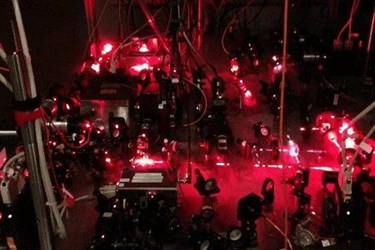MIT, Harvard Scientists Cool Three-Atom Molecule To Near Absolute Zero
By Jof Enriquez,
Follow me on Twitter @jofenriq

Harvard University and Massachusetts Institute of Technology (MIT) researchers have successfully cooled a triatomic molecule to near absolute zero for the first time. The feat could prove useful in building quantum computers and observing chemistry reactions in greater detail.
Laser cooling has been around since the 1970s and is mainly used to create ultracold atoms for experiments in quantum physics. While scientists have been successful at cooling atoms, they have found cooling molecules more challenging, because the more atoms there are in a molecule, the more complex their vibrational and rotational degrees of freedom can get.
To successfully cool a molecule, researchers at the MIT-Harvard Center for Ultracold Atoms (CUA) utilized a cooling mechanism first proposed in 1989 by Nobel Prize-winning scientist Claude Cohen-Tannoudji, called Sisyphus cooling. The method is named after Greek mythology figure Sisyphus, who was cursed for eternity to roll a stone up a hill in the Underworld, only to have the stone roll down again when he reached the top.
In similar fashion, atoms that interact with laser beams move through a potential surface along the direction of the standing wave, or "hill."
As explained on the Nobel Prize page, "When they travel 'uphill' they lose speed. As they reach the top of the 'hill' they are optically pumped to the bottom of a 'valley'. In this way the atoms will always travel 'uphill', and thus their velocity will gradually be reduced."
As the atoms travel along the surface and encounter subsequent waves, the atoms lose more kinetic energy and they get cooler and cooler.
For their experiment, the MIT and Harvard scientists perform magnetically assisted Sisyphus laser cooling of the triatomic free radical strontium monohydroxide (SrOH), which they found ideal to cool since it contains an electron that does not participate very strongly in bonding.
In results published in the journal Physics Review Letters, the researchers wrote of their results, "The transverse temperature of a SrOH molecular beam is reduced in one dimension by 2 orders of magnitude to ∼750 μK. This approach opens a path towards creating a variety of ultracold polyatomic molecules by means of direct laser cooling."
Theoretically, their technique can cool a molecule consisting of up to 15 atoms, according to the research team. Such a method could help future scientists build a molecular quantum computer, because they can control precisely which parts of a molecule are vibrating, and thus store data.
“You can actually use laser light not only to cool atomic molecules but to redial their state precisely,” researcher Ivan Kozyryev told New Scientist.
Another potential application is in chemistry, where reactions can be slowed down to more closely observe the properties and behavior of atoms and molecules as they undergo chemical changes.
